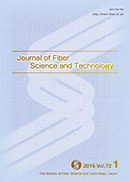
- |<
- <
- 1
- >
- >|
-
Masato Kamogawa, Tetsuo Kondo原稿種別: Transaction
2024 年 80 巻 5 号 p. 100-108
発行日: 2024年
公開日: 2024/05/17
ジャーナル オープンアクセスFor the last decade, cellulose nanofibrils (CNFs) have attracted a considerable attention in utilization of a reinforcing filler for polymer materials because of their excellent physical properties. CNFs (= ACC-CNFs) prepared by aqueous counter collision (ACC) method own more hydrophobic nature on their surfaces than usual CNFs. Moreover, ACC-CNFs favorably adsorb to isotactic polypropylene (iPP) microspheres solely by their mixing in the aqueous dispersion. Recently, the iPP microspheres coated with ACC-CNFs (approximately 0.03 wt% as coverage) yielded an impact-resistant composite material embedding “plant cell wall”-mimicked frameworks via usual injection-molding. As impact-resistance exhibits a trade-off relationship against tensile strength usually in composite materials, the current study focuses on tensile properties of the above composite materials having the impact-resistant properties. The dependence of raw materials for preparation of ACC-CNFs on the properties of the molded products are also examined. As a result, ACC-CNF derived from bamboo bleached kraft pulp (= ACC-BBKP) /iPP microspheres yielded superior values in both elastic modulus and tensile strength without decreasing elongation at break when compared with other ACC-CNFs. Namely, the ACC-BBKP/iPP product has achieved to overcome a trade-off relationship between stiffness and toughness. Contrary to ACC-BBKP, ACC-CNF derived from microcrystalline cellulose allowed to improve stiffness of the product, while the improvement in toughness appeared in the molding product via ACC-CNFs derived from bacterial nanocellulose pellicles.
抄録全体を表示PDF形式でダウンロード (1775K) -
飯塚 茜吏, 荒木 潤, 雨宮 敏子, 濱田 仁美原稿種別: 一般論文
2024 年 80 巻 5 号 p. 109-116
発行日: 2024年
公開日: 2024/05/17
ジャーナル オープンアクセスIn this study, cellulose nanocrystals (CNC), characterized by ultrafine natural fibers measuring several tens of nanometers in width and shorter fiber length compared to cellulose nanofibers (CNF), were incorporated into cotton fabrics through impregnation. Subsequently, functional processing was performed without inducing changes in the physical properties and appearance of the fabric. Moreover, by removing the CNCs from the cotton fabric through washing and applying new CNCs, it is expected that the functionality can be reinstated without damaging the cotton fabric. We aimed to propose a method for functional processing of recyclable cotton fabrics using CNCs. The oxidized CNC-processed fabric demonstrated excellent deodorizing performance for ammonia without manifesting significant changes in physical properties when the CNCs were introduced through impregnation. Although the oxidized CNC-processed fabric with a large amount of CNC adsorption had a high bending rigidity, the ventilation resistance remained unchanged, preserving the characteristic air permeability inherent to cotton fabric. In terms of deodorizing performance, an elevated CNC absorption correlated with increased ammonia deodorizing efficacy attributed to the heightened carboxyl group content capable of capturing ammonia. Quantification of CNC adsorption amount and carboxyl group content on the fabric using toluidine blue O, a cationic dye, revealed that ammonia was adsorbed to approximately 55% of the carboxyl groups on the fabric. Upon subjecting the CNC-treated fabric to a mild washing regimen, it was observed that most of the CNCs detached after several cycles, and the deodorizing performance against ammonia was recovered upon reapplication of CNCs. Remarkably, the oxidized CNCs exhibited excellent deodorizing performance for ammonia and demonstrated their ability to be removed after multiple washing cycles. In the future, by using various chemically modified CNCs, we can expect to add several other functionalities to fabrics.
抄録全体を表示PDF形式でダウンロード (1362K) -
Hideyuki Shima, Michal Vik, Martina Viková, Hidekazu Yasunaga原稿種別: Transaction
2024 年 80 巻 5 号 p. 117-130
発行日: 2024年
公開日: 2024/05/17
ジャーナル オープンアクセスA novel treatment technique to confer functions of capturing and detecting hapten metal ions upon cotton fabric by using laccaic acid (LA) was studied for preventing metal allergy symptoms. Cotton fabrics were treated by the LA with using thionyl chloride and pyridine to give the functions. It was found that the LA-treated cotton fabrics adsorbed nickel ions and showed colour change from orange to deep purple by immersed in nickel chloride aqueous solution. The colour change was clear enough to be perceived by the naked eye. The LA-treated cotton fabric has sufficient adsorption capacity to capture Ni2+. It was evaluated that the LA molecule interacted with ten Ni2+ ions in aqueous solution. The colour change behaviour of the LA-treated cotton fabric by Ni2+ depended on pH. The LA-treated fabric adsorbing Ni and coloured was able to be regenerated repeatedly by washing with citric acid aqueous solution. The LA-treated fabric also detected Co2+, Cr3+, Cu2+, Zn2+ and Fe2+ ions by the colour change and the resulting colour depends upon the type of metal ions. The LA-treated fabric functioned for metal ions from metal alloys in artificial sweat solution.
抄録全体を表示PDF形式でダウンロード (1600K)
- |<
- <
- 1
- >
- >|